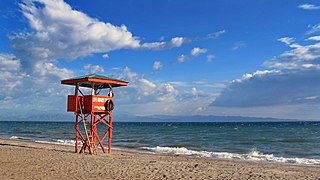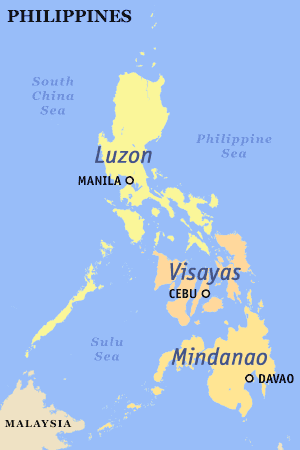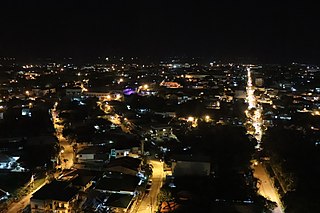
Mindanao is the second-largest island in the Philippines, after Luzon, and seventh-most populous island in the world. Located in the southern region of the archipelago, the island is part of an island group of the same name that also includes its adjacent islands, notably the Sulu Archipelago. According to the 2020 census, Mindanao had a population of 26,252,442, while the entire island group had an estimated population of 27,021,036.

In the Philippines, regions are administrative divisions that primarily serve to coordinate planning and organize national government services across multiple local government units (LGUs). Most national government offices provide services through their regional branches instead of having direct provincial or city offices. Regional offices are usually but not necessarily located in the city designated as the regional center.

Davao Region, formerly called Southern Mindanao, is an administrative region in the Philippines, designated as Region XI. It is situated at the southeastern portion of Mindanao and comprises five provinces: Davao de Oro, Davao del Norte, Davao del Sur, Davao Oriental, and Davao Occidental.

Caraga, officially the Caraga Administrative Region and designated as Region XIII, is an administrative region in the Philippines occupying the northeastern section of Mindanao. The region was created through Republic Act No. 7901 on February 23, 1995. The region comprises five provinces: Agusan del Norte, Agusan del Sur, Dinagat Islands, Surigao del Norte, and Surigao del Sur; six cities: Bayugan, Bislig, Butuan, Cabadbaran, Surigao and Tandag; 67 municipalities and 1,311 barangays. Butuan, the most urbanized city in Caraga, serves as the regional administrative center.

Soccsksargen, formerly known as Central Mindanao, is an administrative region of the Philippines, designated as Region XII. Located in south-central Mindanao, its name is an acronym that stands for the region's four provinces and one highly urbanized city. The regional center is in Koronadal, located in the province of Cotabato del Sur, and the center of commerce and industry is General Santos, which is the most populous city in the region.

Iligan, officially the City of Iligan, is a highly urbanized city in the region of Northern Mindanao, Philippines. According to the 2020 census, it has a population of 363,115 people making it the second most populous city in Northern Mindanao after Cagayan de Oro.

Davao City, officially the City of Davao, is a highly urbanized city in the Davao Region, Philippines. The city has a total land area of 2,443.61 km2 (943.48 sq mi), making it the largest city in the Philippines in terms of land area. It is the third-most populous city in the Philippines after Quezon City and Manila respectively, and the most populous city in Mindanao, in Davao Region, and outside of Metro Manila. According to the 2020 census, it has a population of 1,776,949 people.

Tagum, officially the City of Tagum, is a component city and capital of the Davao del Norte, Philippines. According to the 2020 census, it has a population of 296,202 people making it the most populous component city in Mindanao and in Davao del Norte, as well as the second most populous in Davao Region after Davao City.
The Philippines is divided into four levels of administrative divisions, with the lower three being defined in the Local Government Code of 1991 as local government units (LGUs). They are, from the highest to the lowest:
- Regions are mostly used to organize national services. Of the 17 regions, only one—the Bangsamoro Autonomous Region in Muslim Mindanao—has an elected government to which the central government has devolved competencies.
- Provinces, independent cities, and one independent municipality (Pateros)
- Component cities and municipalities within a province
- Barangays within a city or municipality
The super regions of the Philippines are an informal and de facto defunct grouping of parts of regions and provinces of the Philippines based on their economic strengths. According to Executive Order No. 561, which establishes these regions,
"[These] groupings neither supersede current political boundaries nor alter the regional development councils as established by existing laws and issuances."

The Philippines is divided into three major island groups: Luzon, the Visayas, and Mindanao. Luzon and Mindanao archipelagoes are both named after the largest island in their respective groups, while the Visayas is an archipelago of roughly similar-sized islands.

The Christian And Missionary Alliance Churches of the Philippines (CAMACOP) is a Christian evangelical group in the Philippines that originated from The Christian and Missionary Alliance (C&MA). It is one of the largest evangelical groups in the Philippines.

The following outline is provided as an overview of and topical guide to the Philippines:

Metro Davao, officially Metropolitan Davao, is a metropolitan area in Mindanao, Philippines. It includes the cities of Davao, Digos, Mati, Panabo, Samal and Tagum and spanned parts of all five provinces of the Davao Region. Metro Davao is one of three metropolitan areas in the Philippines. It is administered by the Metropolitan Davao Development Authority. It is the largest metropolitan region by land area and the second most populous in the Philippines.
Datu Yusoph Boyog Mama is a Filipino politician and government official. He was a candidate for public office as Autonomous Region in Muslim Mindanao (ARMM) Regional Governor in the previous 2013 Mid-term Elections, being the lone candidate representing the province of Lanao del Sur, one of the five (5) provinces constituting the ARMM territory. With the support of various key multi-sectoral groups in the province of Lanao del Sur and the provincial capital Islamic City of Marawi, Datu Yusoph B. Mama ran as an independent candidate.
The 2012–13 PFF National Men's Club Championship was the 2nd season of the PFF National Men's Club Championship, a Filipino association football competition organized by the Philippine Football Federation.

The mayor of Davao City is the chief executive of the government of Davao City in Davao Region, Philippines. The mayor leads the city's departments in executing ordinances and delivering public services. The mayorship is a three-year term and each mayor is restricted to three consecutive terms, totalling nine years, although a mayor can be elected again after an interruption of one term.

An autonomous region of the Philippines is a first-level administrative division that has the authority to control a region's culture and economy. The Constitution of the Philippines allows for two autonomous regions: in the Cordilleras and in Muslim Mindanao. Currently, Bangsamoro, which largely consists of the Muslim-majority areas of Mindanao, is the only autonomous region in the country.

The Isyu Ngayon series was a brand of regional news magazine shows of different GMA Regional TV stations in the Philippines. They were aired weekly in Dagupan, Cebu, Iloilo and Davao on Saturday mornings; and aired daily in Naga, Bacolod, Cagayan de Oro and General Santos. The Isyu Ngayon family of programs was not available in the Metro Manila market. Its editions in Naga, Iloilo, Bacolod and Davao were aired internationally via GMA News TV International.














